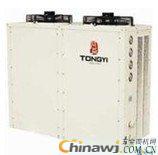Ground-source heat pumps are systems that utilize the stable temperature of shallow ground or groundwater to provide heating or cooling for buildings. This technology works by exchanging heat between a conventional air-conditioning system and the ground, often using an intermediate fluid as a heat carrier. The fluid circulates in a closed loop through underground pipes, allowing energy to be transferred efficiently. As a result, this method offers a sustainable and environmentally friendly way to manage indoor climate conditions.
According to the "GB50176-1993 Code for Thermal Design of Civil Buildings," in regions with hot summers and cold winters, the number of cooling and heating days is roughly equal, meaning that the heating and cooling loads are balanced. This makes ground-source heat pump systems particularly effective in these areas, as they can take full advantage of the thermal storage capacity of the shallow ground. Due to its efficiency and environmental benefits, this technology is often referred to as "the most effective air conditioning technology of the 21st century."
In China, research on ground-source heat pump systems has mainly focused on underground heat exchangers. With the increasing maturity of heat pump technology, the design and construction of these exchangers have become a critical area of study. This article presents the author’s involvement in further research on geothermal heat pump systems, specifically in Changchun City, where geotechnical factors play a major role in system performance.
Engineering drilling is a crucial step in constructing underground heat exchangers. These exchangers are typically installed at depths ranging from 40 to 100 meters, making the construction process relatively straightforward. Commonly used drilling equipment includes engineering survey rigs or shallow core drills. Table 1 outlines several common types of drilling rigs along with their key specifications.
Drilling methods are usually simple, with rotary drilling—either positive or reverse circulation—being the most widely used. Before starting the drilling process, it's essential to understand the site's geological conditions and identify any existing underground pipelines. It's also important to detect and address any issues that may arise during drilling, such as borehole collapse, which can impact the safety and effectiveness of the system.
Site preparation is equally important. The area must be cleared of weeds, debris, and loose soil, and the exact location of each borehole should be marked. To manage slurry overflow during grouting, drainage channels are often designed and constructed in advance. These channels can lead to a grouting tank where the slurry can settle before being reused as backfill material.
Environmental protection is a key concern during construction. Special attention must be given to preventing antifreeze leaks, which can occur due to improper installation. In areas with Quaternary loose formations, casing is required to protect the surrounding environment. Therefore, the hole structure must be carefully planned based on the results of preliminary geological surveys.
When installing ground-source heat pumps in northern regions, the depth of buried pipes should be determined according to the local frost line. For example, in Changchun, where the frost depth ranges from 140 cm to 170 cm, horizontal pipes are typically buried about 250 cm deep. In southern regions, where freezing is less of a concern, pipe burial depth is generally less than 100 cm to account for seasonal changes and potential damage from vegetation.
The U-tube connection method is vital for ensuring the system's long-term performance. The pipes must be chemically stable, resistant to corrosion, and have good thermal conductivity. The most common method for connecting U-tubes is through hot-melt welding. This process involves trimming, cleaning, aligning, and heating the ends of the tubes until they melt and fuse together. Hot-melt connections are preferred because they offer higher strength than the tube itself, prevent corrosion, and are recommended by industry standards.
There are two main hot-melt techniques: socket and butt fusion. Socket connections involve welding the ends of two U-tubes into a thicker receiving pipe, while butt fusion joins the ends directly after heating them with a plate. Each joint only needs one heating cycle. After welding, the tubes must be aligned and cooled for 20 seconds to ensure proper bonding. During winter construction, the process should be done indoors to avoid cold-related issues.
Once the borehole is drilled, the U-tube must be lowered immediately to prevent sediment buildup, which could reduce the effective depth of the hole. Lowering the U-tube is a critical step that requires careful handling. Currently, this process is still largely manual, requiring coordination among workers to straighten, lower, and position the pipes properly. Maintaining concentricity is essential to avoid heat exchanger short circuits.
After the U-tube is in place, it must be secured to prevent floating and sealed to keep out debris. Grouting follows, involving mixing cement, bentonite, sand, and water in a mixer before pumping the slurry into the borehole under pressure. The grouting process continues until the slurry levels match on both sides, indicating a complete fill. Proper grouting ensures the integrity and efficiency of the entire system.

HSONG LIGHTING CO,. LTD , https://www.hsonglighting.com